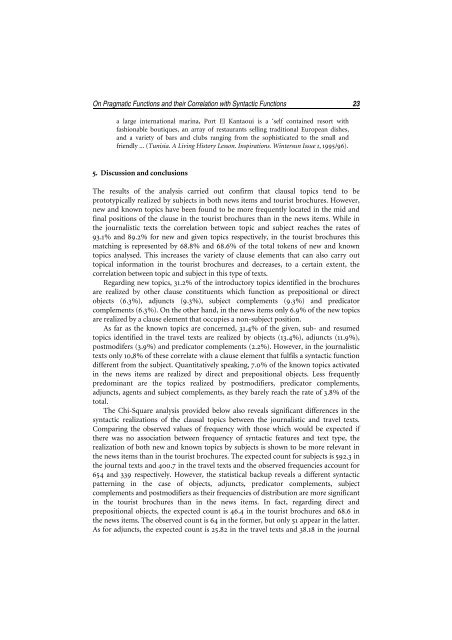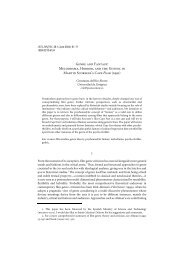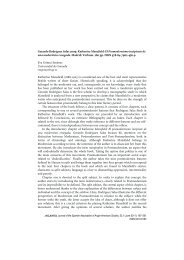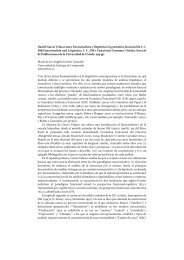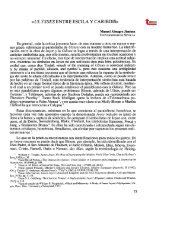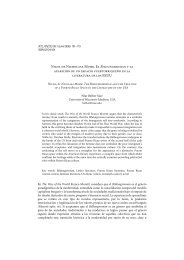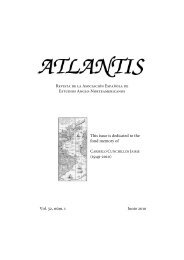On Pragmatic Functions and their Correlation with Syntactic - Atlantis
On Pragmatic Functions and their Correlation with Syntactic - Atlantis
On Pragmatic Functions and their Correlation with Syntactic - Atlantis
You also want an ePaper? Increase the reach of your titles
YUMPU automatically turns print PDFs into web optimized ePapers that Google loves.
<strong>On</strong> <strong>Pragmatic</strong> <strong>Functions</strong> <strong>and</strong> <strong>their</strong> <strong>Correlation</strong> <strong>with</strong> <strong>Syntactic</strong> <strong>Functions</strong> 23<br />
a large international marina, Port El Kantaoui is a ‘self contained resort <strong>with</strong><br />
fashionable boutiques, an array of restaurants selling traditional European dishes,<br />
<strong>and</strong> a variety of bars <strong>and</strong> clubs ranging from the sophisticated to the small <strong>and</strong><br />
friendly ... (Tunisia. A Living History Lesson. Inspirations. Wintersun Issue 1, 1995/96).<br />
5. Discussion <strong>and</strong> conclusions<br />
The results of the analysis carried out confirm that clausal topics tend to be<br />
prototypically realized by subjects in both news items <strong>and</strong> tourist brochures. However,<br />
new <strong>and</strong> known topics have been found to be more frequently located in the mid <strong>and</strong><br />
final positions of the clause in the tourist brochures than in the news items. While in<br />
the journalistic texts the correlation between topic <strong>and</strong> subject reaches the rates of<br />
93.1% <strong>and</strong> 89.2% for new <strong>and</strong> given topics respectively, in the tourist brochures this<br />
matching is represented by 68.8% <strong>and</strong> 68.6% of the total tokens of new <strong>and</strong> known<br />
topics analysed. This increases the variety of clause elements that can also carry out<br />
topical information in the tourist brochures <strong>and</strong> decreases, to a certain extent, the<br />
correlation between topic <strong>and</strong> subject in this type of texts.<br />
Regarding new topics, 31.2% of the introductory topics identified in the brochures<br />
are realized by other clause constituents which function as prepositional or direct<br />
objects (6.3%), adjuncts (9.3%), subject complements (9.3%) <strong>and</strong> predicator<br />
complements (6.3%). <strong>On</strong> the other h<strong>and</strong>, in the news items only 6.9% of the new topics<br />
are realized by a clause element that occupies a non-subject position.<br />
As far as the known topics are concerned, 31.4% of the given, sub- <strong>and</strong> resumed<br />
topics identified in the travel texts are realized by objects (13.4%), adjuncts (11.9%),<br />
postmodifers (3.9%) <strong>and</strong> predicator complements (2.2%). However, in the journalistic<br />
texts only 10,8% of these correlate <strong>with</strong> a clause element that fulfils a syntactic function<br />
different from the subject. Quantitatively speaking, 7.0% of the known topics activated<br />
in the news items are realized by direct <strong>and</strong> prepositional objects. Less frequently<br />
predominant are the topics realized by postmodifiers, predicator complements,<br />
adjuncts, agents <strong>and</strong> subject complements, as they barely reach the rate of 3.8% of the<br />
total.<br />
The Chi-Square analysis provided below also reveals significant differences in the<br />
syntactic realizations of the clausal topics between the journalistic <strong>and</strong> travel texts.<br />
Comparing the observed values of frequency <strong>with</strong> those which would be expected if<br />
there was no association between frequency of syntactic features <strong>and</strong> text type, the<br />
realization of both new <strong>and</strong> known topics by subjects is shown to be more relevant in<br />
the news items than in the tourist brochures. The expected count for subjects is 592.3 in<br />
the journal texts <strong>and</strong> 400.7 in the travel texts <strong>and</strong> the observed frequencies account for<br />
654 <strong>and</strong> 339 respectively. However, the statistical backup reveals a different syntactic<br />
patterning in the case of objects, adjuncts, predicator complements, subject<br />
complements <strong>and</strong> postmodifiers as <strong>their</strong> frequencies of distribution are more significant<br />
in the tourist brochures than in the news items. In fact, regarding direct <strong>and</strong><br />
prepositional objects, the expected count is 46.4 in the tourist brochures <strong>and</strong> 68.6 in<br />
the news items. The observed count is 64 in the former, but only 51 appear in the latter.<br />
As for adjuncts, the expected count is 25.82 in the travel texts <strong>and</strong> 38.18 in the journal


